What is
the Internet of Things?
The Internet of Things (or IoT) revolves around our everyday life, collecting data depending on a person’s shopping tastes, sleep and work timings, browser cookies and much more. The IoT is a giant network of a cluster of numerous data collected from around the environment. That includes different objects of all shapes and sizes with in-built sensors that transmit data – from microwaves to self-driving cars and fitness devices to alarm clocks.
How
does IoT work?
The IoT collects data from various sources and
uses that to provide a proper solution based on the user’s requirements.
For instance, you set your alarm at a specific
time every day to wake up for work. However, when something goes wrong – a
cancelled
train or an alternate route due to bad weather, you’ll have to wake up early in
order to reach your office on time. An IoT-enabled alarm collects data with the
factors like driving distance, travel time for the alternate route and the
current weather conditions. Based on the data, it calculates when to wake you
up so you are not late for work.
Furthermore, to develop, manage and host all these applications you need a fully-functional and flexible technology infrastructure platform. The IoT development platform is a multi-layered technology that helps in management, provisioning and automation of the hardware devices connected to the IoT. The development platform helps a user to develop, deploy and manage various IoT applications. It acts as a powerful toolkit to connect numerous sensors and devices from across the world to the cloud wherein the entire data is stored for further usage.
The platforms are evaluated based on the
following fundamental components –
- Device management
- Integration
- Security
- Data collection
- Analytics
- Support for visualizations
Amazon
Web Services (AWS) IoT
Owned by Amazon, the AWS IoT development
platform enables the user to connect different hardware devices or the mobile
application to not only AWS services but also other devices. It also helps the
user to secure the data interactions, act upon the data available and even the
authority to allow applications to interact with the devices even when they are
offline.
The AWS IoT Software Development Kit (SDK)
helps the user to enable the hardware devices to connect, authenticate and
exchange data using HyperText Transfer Protocol (HTTP), Message
Queuing Telemetry Transport (MQTT) or WebSockets protocols. The AWS enables the
user to use a source alternative and even write their own SDK.
A few of the benefits provided by the AWS IoT
SDK are –
- Device
Gateway
- Message
Broker
- Mutual
authentication and authorization
- Registry
- Device
shadow
- Rules
Engine
Microsoft
Azure IoT
Developed by Microsoft, Azure is one of the
topmost IoT platforms. The Azure IoT platform has been designed and developed
in order to deliver the data collection and analysis in the most efficient way
possible. This helps the organizations to make not only quick but also accurate
decisions which in turn enables them to build more products at more competitive
prices.
A few of the benefits provided by the
Microsoft Azure IoT are –
- Application services
- Messaging facility
- Condition monitoring
- Virtual mechanisms
- Data storage services
- Highly efficient database
management structures
Google
Cloud Platform
Google cloud platform is one of the most popular
platforms, which is easy to use and provides different user-friendly features.
With the ability to provide advanced analytics owing to Google’s Cloud Data
Studio and Big Query, this platform stands out from the rest. Google cloud’s
main purpose is to provide intelligence and data security.
A few of the benefits provided by the Google
cloud platform are –
- Data management
- Application development
- Smart business analytics and AI
- Productivity and work
transformation
- Expandable NoSQL database systems
ThingWorx
IoT Platform
ThingWorx IoT Platform is owned by PTC – the
creator of CAD. This IoT platform enables the users to gain new insights from
the data sourced from various devices and at the same time, it maintains the
transfer speed. It also allows the organization to upgrade or replace back-end
systems without disrupting the user experience in any way.
This IoT platform allows the users to connect
to various devices across the network and also provides a quick analysis of
complicated data and content.
A few of the benefits provided by the
ThingWorx IoT Platform are –
- Easy connectivity across the
network
- Ability to share the platform
among developers
- User-friendly interface for
developing applications
- Integrated machine learning
- Ability to deploy embedded, cloud
and on-premise IoT solutions on the go
Cisco
IoT Cloud Connect
Created by Cisco, this IoT platform is mainly
designed for mobile operators. This platform offers various services such as
completely customizable billing and reporting system, effective and efficient
data and voice connectivity, security and a user-friendly interface for
managing the applications. While enabling mobile operators to enjoy IoT
services, Cisco IoT can also be used to build multiple products and utilize the
resources at the same time.
A few of the benefits provided by the Cisco
IoT Cloud Connect are –
- Voice and data connectivity
- SIM life-cycle management
- IP session control
- Customizable billing and reporting



